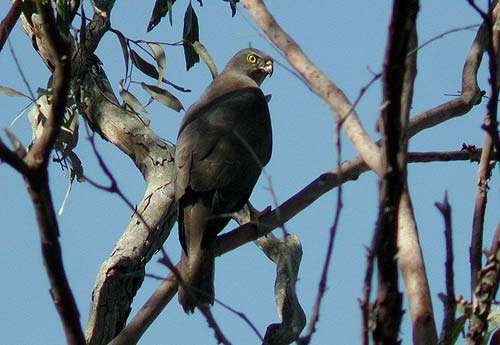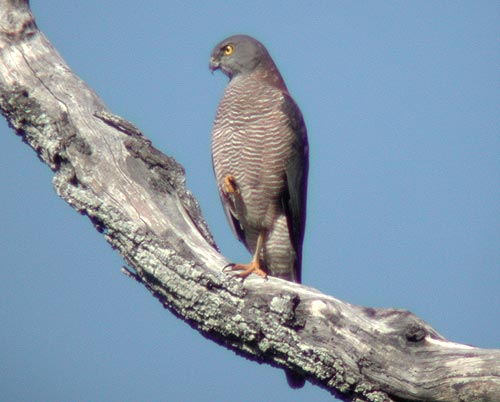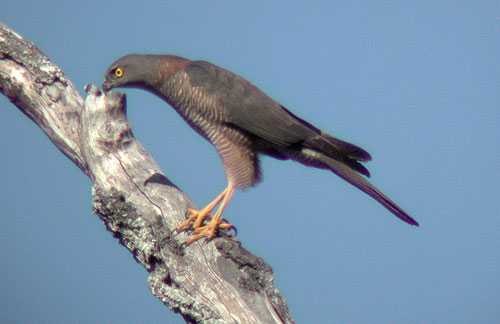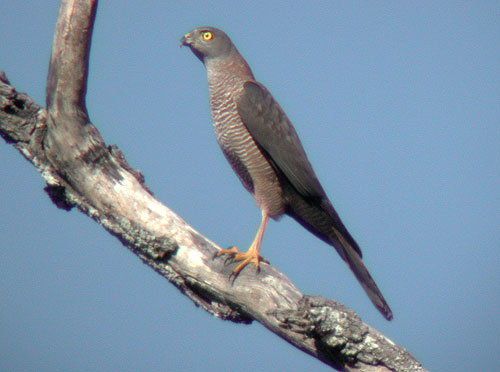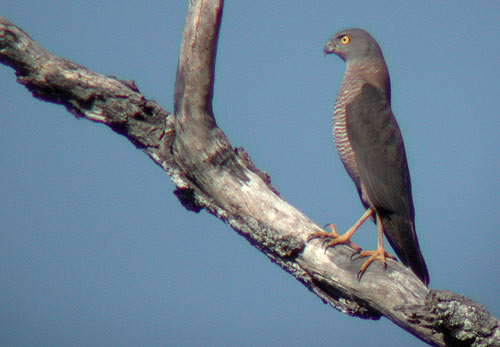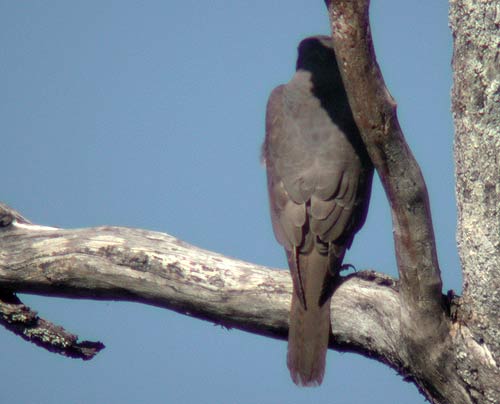|
Comments Received
These are
Brown Goshawks!! How's that for confidence? Your dilemma actually confirms
my belief that these two species are much harder to separate than many
people claim. I am constantly amazed at how easily some people are able to
confidently ID these species. For several years now I have been seeing Brown
Goshawks/Collared Sparrowhawks around my place at Woody Point and have spent
many hours observing the actual birds as well as video and still images
trying to positively ID them.
The conclusion
I have come to is that I am seeing mainly Collared Sparrowhawks with the
occasional Brown Goshawk. I believe I have only captured images of Collared
Sparrowhawk. The attached images (no where near as good as your beauties)
are of a couple of Collared Sparrowhawks, mature and juvenile, for your
interest and comparison. The main feature that makes me think your birds are
Brown Goshawks is the size and shape of the head and beak.
If
you have seen Bob Forsyth's ID chart for these two species he has the
details of the heads (which, in my copy, he calls hawk, probably a typo) and
beaks the wrong way around, I believe. The obviously notched tails on the
mature bird in my attached images make them Collared Sparrowhawks (m?) so I
think it is reasonable to use these to compare their heads and beaks with
the birds in your images. HANZAB points out that the COSH has a smaller head
(apparent in my pictures) than the BGOS. The BGOS has a stronger beak and a
more 'beetled' brow than the COSH. Those two feature are apparent in my
images also. The Collared Sparrowhawks I have observed have never had the
obvious brow your birds exhibit but have a much more open-eyed staring look.
You may notice that 'my' birds appear to have more white around the vent
area than 'your' birds. I don't know if this is diagnostic; it is not
mentioned in the references I have. The middle toe on 'your' birds doesn't
appear to me to be extra long. I believe that the length of middle toe is a
somewhat misunderstood diagnostic point. Both birds have long middle toes
but the Sparrowhawk always has the longer. Whether this is observable in the
field is debatable. I would suggest that a great deal of practice and
therefore familiarity would be needed to be able to use this feature
confidently. Measurements appear to have been taken minus the toe-nail. I
have not been able to determine the exact ratio of lengths of the middle toe
to the other toes of each species from my references. Have you seen Stephen
Debus's condensed version of the HANZAB section on birds of prey: The Birds
of Prey of Australia, a Field Guide"? It has the same colour plates as
HANZAB and a field guide version of the text.
Cheers Bob
Inglis
Based on nothing but the photos (missing size & flight
style cues etc) I would say they are all of a BG. There is no reason why
both ids could not have been correct. As I read your story you first thought
you had a pair of CS, then found & photographed what certainly shows typical
features of a BG. Another feature that you don't mention is the big beak is
typical of BG. The CS has a much smaller beak. Rather than doubting
yourself, is there any reason to doubt that both species were there and seen
at different times?
Philip Veerman
I'm voting for Brown Goshawk. The `beetle brow',
rounded tail & relatively normal length of the middle toe.
Chris
Barnes
A reply to your request on identifying COSH and BGOS
from a part of the world where both species do not occur. I have been
visiting Irian Jaya/Papua regularly and observed COSH several times (as well
as Australia once in suitable BGOS habitat but failed to observe it). Next,
I have checked with some id-guides (Raptors of the World (RotW), HBW II,
Simpson&Day)
In my opinion this is a BGOS...
COSH is of a similar structure/size as 'our' (Northern) sparrowhawk (A.
nisus). Though a comparison with other birds cannot be made, your bird(s)
look somewhat bigger, have a bigger head/neck.
The eyes of your bird give a much more aggressive expression with the heavy
brow ridges while COSH looks somewhat silly with the open face/eyes. In all
pictures this difference is obvious.
In RotW both subspecies of COSH (A.c. quaesitandus) and BGOS (A.f.didimus)
of northern Australia are depicted. They are both somewhat greyer than the
nominates, but still BOGS is clearly a darker bird. This seems to be the
case in your bird(s). Next, A.f.didimus is said to have a squarer tail than
the nominate.
The legs look strong and talons short, but everytime I look to your pictures
I start doubting... Bigger fits better with BGOS.
Just as you did, I go for my first impression, recalling my observations of
COSH as a more slender, agile bird I put my money on BGOS.
good luck, hope to hear how far you get,
best wishes,
Marc Argeloo
Amsterdam
I like to try my hand at these things. As a Regional
Editor in New York State, I often get to do this for out-of area birds..
Never been to Australia, but I have an American edition of Field Guide to
Birds of Australia by Simpson and Day.
The plates show that the primaries of the Collared Sparrowhawk project quite
a bit further down than the end of the under tail coverts when perched. On
the Brown Goshawk, the primaries are about even with the end of the under
tail coverts. Painters can be good or bad, but they almost always get these
type of measurements correct even in the event the birds don't quite look
right. They take measurements of skins to insure accuracy. Look at your
field guide and then the pictures to see what I'm pointing out and to
satisfy yourself
(My experience with North American accipiters is that the tail shape on a
perched bird may not always be completely reliable for an ID).
SY SCHIFF
The male Goshawk/female Sparrowhawk ID problem is
always a problem. Fortunately we have both species about the place in
Melbourne and I would say that both birds in your pictures are Brown
Goshawks, going by the frowning brow-ridge in both birds and the rounded
tail end. The leggy, slender look of the tercel Goshawk is typical.
(I picked up a roadkill bird some years ago and made detailed drawings -
measurement showed it was a Gos in the end but I was in some doubt for a
while. Some members of my art class were quite horrified!).
The middle toe in the Sparrowhawk is *really* twice as long as the side toes
and it is incredibly high on the leg and the head is rounded with
protuberant eyes, no brow-ridge.
In flight the Sparrowhawk has more curvy wing outline than the Goshawk,
almost 'Cupid'-bow' in effect.
Anthea Fleming in Ivanhoe (Vic)
I was
awaiting replies to your mail with interest having had a look at your
pictures but as none were forthcoming I thought I'd have a go myself. I must
stress that I've never seen either of these birds having never visited
Australia but have based my comments on the only book I have on Australian
birds, "A Field guide To The Birds of Australia" by Graham Pizzey,
illustrated by Roy Doyle.
Having looked these birds up I can appreciate your problem. The tail is
indeed rounded as in the Goshawk and not flat or slightly
forked when perched as described for the Sparrowhawk. The eye also looks
like the Goshawk having that heavy browed look which gives the Goshawk the
glaring face. The legs also look fairly heavy like Goshawk.
On the other hand the middle toe does look longer than the outer ones which
would point to Collared Sparrowhawk. If as you say you are familiar with the
call of the Sparrowhawk that should tie it up but the male Goshawk also
gives the "kikiki" call but not as high pitched or as fast as the
Sparrowhawk. Having never heard them I couldn't say how much of a difference
there really is.
As there were two adult birds I would have assumed they would be a pair and
whilst the size of the female Sparrowhawk and male Goshawk might be similar,
there should be a huge difference in size between the male Sparrowhawk and
the female Goshawk. Was there any noticeable difference in size between the
two birds that you saw? The sizes are not really obvious in the photographs.
I don't really seem to have come to any more of a definite decision than you
did but I think the size and the call would give the best
clues.
John Connolly Somerset, UK.
Surprised you're having trouble with this one! The bird is clearly a Brown
Goshawk, although it's unusual for them to be as confiding as these two.
Collared Sparrowhawks are in my experience much more likely to allow a close
approach.
To clear up what seems to be the main point of confusion, the middle toe
should be even longer for a Collared Sparrowhawk, but just as important, the
legs should be much finer. In all other respects these birds look like your
"classic" BGOS, esp. tail and scowling face.
Andrew Stafford
My vote goes to the Brown Goshawk.
Why do I say "Brown Goshawk"?
For several years now I have been trying to ID the Collared
Sparrowhawk/Brown Goshawks that visit me from time to time at Woody Point in
the south east of Queensland, Australia.
I have spent many hours studying the actual birds and the video and digital
still pictures I have managed to obtain.
The pictures I have produced are nowhere near as good as the excellent
images that Tom has posted on his web page:
http://www.aviceda.org/accipiter.htm (If you haven't looked at them yet, do
it now!)
The conclusion that I have come to with 'my' birds is that they are mostly
Collared Sparrowhawks with the rare Brown Goshawk.
This ID has been achieved from the shape of the tail which in most cases is
very 'notched' and the shape and size of the head.
To me 'Tom's' birds show the attributes of Brown Goshawk notwithstanding
what he says about the centre-toe length.
The second bird (rear view only) would have to be called a Brown Goshawk
based on the tail shape there being no other obvious feature to analyse.
It would be a bit hard to imagine that a Collared Sparrowhawk would wear its
tail down from the usual 'squared corners with a slight (at least) notched'
look to a distinctly 'rounded' look as is on this bird.
The first bird has what I would call the classic Brown Goshawk head and
beak. The BGOS has a larger head and more substantial beak than the COSH
(sorry Bob F. the ID chart you sent me a while back has this feature
reversed).
The BGOS also has a more 'beetled' brow giving it a 'scowling' look compared
to the more 'open-eyed' look of the COSH.
I think the centre toe measurement is a somewhat misunderstood and
misleading feature.
Both of these species have long middle toes but the COSH has the longest.
Even though 'Tom's' bird 1 has obviously long centre toes I don't believe
that makes it a COSH.
I suggest that for the BGOS the centre toe MINUS the toe-nail is roughly the
length of the other toes INCLUDING the toe-nail.
For the COSH, the centre toe MINUS the toe-nail is much longer than the
other toes INCLUDING the toe-nail.
I welcome comment on that statement.
Anyhow that's what I think.....
Incidentally, if you can't afford the award-winning Handbook of Australian
New Zealand and Antarctic Birds (HANZAB) Vol 2 (Raptors to Lapwings) I
suggest you all look for a copy of Stephen Debus's condensed version of the
HANZAB bird of
prey section: "The Birds Of Prey of Australia A Field Guide".
It has the same colour plates as HANZAB and a 'field guide' version of the
HANZAB text compiled in a 'pocket size' format.
Worth having.
Bob Inglis
I reckon
Collared Sparrowhawk. Just down to jizz - nothing more technical than that.
Keith Betton
I have
changed my mind. The bird in photos three, four and five are definitely
Brown Goshawk. When I went to the museum, the size of the legs was a very
noticable difference between sparrowhawk and goshawk.
Frank O'Connor Birding WA
http://members.iinet.net.au/~foconnor
I have had a look at the pics and go for Brown
Gos. On balance it has more BG features than CS. The frown and solid overall
build are very definitely BG, the tail tip is worn but seems more rounded
than square.
Regarding that middle toe - if you look closely (and you have to use all the
pics), the middle toe is long but not quite long enough to my mind - the
terminal toe segment should not overlap with the talons of the other toes -
in BG they at least overlap all but the last third to half of this segment.
[Robert - remember the specimen brought in when you were last here.]
Re: the fine barring you do get some very finely barred BGs. I think that we
have one or two in the QM collection from memory.
So, its a Brown Gos in my book. Anyone for a hybrid if opinions are
polarised? Just kidding!
Gregory Czechura
Inquiry Centre
Queensland Museum
PO Box 3300
South Bank Qld 4101
Australia
|
